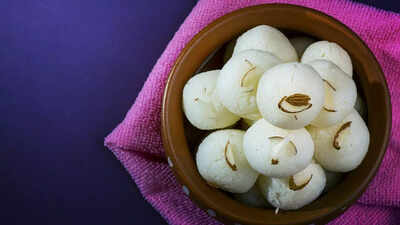ARTICLE AD BOX

Rasgulla is one of the most beloved sweets from India, especially in West Bengal and Odisha, known for its soft, spongy texture and melt-in-the-mouth sweetness. It is often enjoyed during festivals, weddings, and celebrations across South Asia.
But if you have ever wondered what rasgulla is called in English, the answer is not straightforward. There is no single English word for rasgulla. It is commonly described as a “syrup-soaked cottage cheese ball”, “Bengali sweet dumpling”, or simply referred to by its original name, rasgulla, as it is so unique to Indian cuisine.
English names for the famous Indian sweet: Rasgulla
Rasgulla is a syrupy dessert made from chhena (fresh Indian cottage cheese) and semolina, shaped into balls and boiled in light sugar syrup.
Its delicate sponginess and ability to absorb syrup make it stand apart from most other sweets.Origins: Rasgulla is deeply rooted in Indian tradition, with Odisha and West Bengal both claiming its invention. It gained national and international recognition as a symbol of Bengali sweets.Cultural significance: In India, rasgulla is served during major festivals, family celebrations, and as a symbol of hospitality.
Since rasgulla is unique, there is no one-word English equivalent. Instead, people describe it in terms that non-Indians can relate to:
- Syrup-soaked cottage cheese ball highlights its chhena base and juicy syrup.
- Indian milk dumpling points to its shape and dairy origin.
- Spongy sweet dessert ball describes its texture and sweetness.
These descriptions make it easier for people unfamiliar with Indian cuisine to imagine what rasgulla is like.
Health considerations of rasgulla consumption
Though rasgulla is lighter than many fried Indian sweets, it remains sugar-heavy and should be eaten in moderation.1. Diabetes: Rasgulla is soaked in sugar syrup, which makes it high on the glycaemic index and capable of causing rapid spikes in blood glucose.
For diabetics, this can be risky if consumed frequently or in large amounts. A healthier option may include sugar-free rasgullas made with stevia or reduced sugar syrup. Pairing rasgulla with protein-rich foods like nuts or milk can also slow down sugar absorption.2. Weight management: Compared to fried sweets like jalebi or gulab jamun, rasgulla is relatively light because it is boiled, not fried. This makes it lower in fat and somewhat less calorie-dense.
However, the sugar syrup contributes significantly to its calorie load. Eating one or two pieces occasionally may fit into a calorie-conscious diet, but regular indulgence can still lead to weight gain. Opting for mini rasgullas or draining excess syrup before eating can reduce the calorie intake.3. Heart health: Rasgulla is made primarily from milk solids (chhena), which provide protein and calcium without excessive saturated fat.
This makes it lighter on the heart compared to ghee-laden sweets. However, the high sugar content can indirectly impact cardiovascular health by contributing to insulin resistance, obesity, and metabolic syndrome when consumed excessively. Choosing low-sugar versions or enjoying rasgulla occasionally as part of a balanced diet minimises these risks.4. Dental health: The syrupy sweetness of rasgulla can cling to teeth, increasing the risk of cavities and tooth decay if oral hygiene is neglected.
Rinsing your mouth or brushing after eating can help maintain dental health.5. Nutritional value: Despite being a dessert, rasgulla provides some nutritional benefits. Chhena offers protein, calcium, and phosphorus, which are good for bones and muscles. So, while not an everyday food, rasgulla can be a better choice than heavily fried sweets when eaten occasionally.
Tips for healthier enjoyment
- Choose smaller servings to satisfy cravings without overloading on sugar.
- Opt for sugar-free or jaggery-based rasgullas for a healthier twist.
- Balance with protein-rich foods to slow down sugar absorption.
- Enjoy earlier in the day rather than late at night.
- Combine with fruits to balance overall nutrition.
Ingredients and preparation of rasgulla
The main ingredients of rasgulla are:
- Chhena (Indian cottage cheese) – the core ingredient.
- Semolina (sooji) – helps bind the chhena.
- Sugar syrup – light and mildly flavoured, often with rose water or cardamom.
How it’s made:Fresh chhena is kneaded with a small amount of semolina to form a smooth dough.Small balls are rolled and gently simmered in boiling sugar syrup.As they cook, the rasgullas absorb the syrup, becoming soft, juicy, and spongy.
Cultural significance of rasgulla
Rasgulla is more than just a dessert, it is an emotional and cultural icon:Festivals and celebrations: A must-have during Durga Puja, weddings, and festive feasts.Regional pride: Both Odisha and Bengal claim rasgulla as their heritage sweet.Global recognition: Today, rasgulla is exported worldwide and continues to win hearts as a symbol of Indian mithai.Also read | Sweet potato for weight loss: How shakarkandi can help you flatten your belly



.png)
.png)
.png)
















 20 hours ago
4
20 hours ago
4








 English (US) ·
English (US) ·